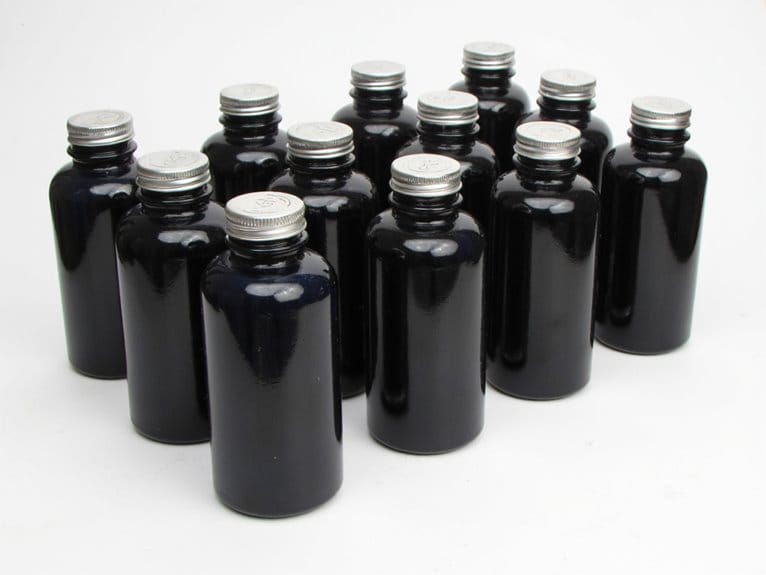We are supported by our audience. When you purchase through links on our site, we may earn an affiliate commission, at no extra cost for you. Learn more. Last update on 4th July 2025 / Images from Amazon Product Advertising API.
Citadel Paints, a popular choice for miniature painting enthusiasts, contain a complex mixture of ingredients that can pose potential skin irritation and allergic reaction risks, making it essential to understand the safety concerns and take necessary precautions. While the paints’ resins, pigments, and additives contribute to their vibrant colors and finishes, they can also cause skin irritation, ranging from mild redness to severe blistering. To guarantee a safe painting experience, it’s vital to wear protective gloves, wash hands thoroughly, and maintain good ventilation. By taking these steps, enthusiasts can minimize risks and continue to enjoy their hobby, with further guidance awaiting those who wish to investigate additional safety measures. For those seeking top miniature paints with a focus on safety, it’s advisable to look for non-toxic, water-based options that are specifically formulated for hobbyists. These paints often contain fewer harsh chemicals and are designed to be gentler on the skin. Additionally, reading product labels and researching customer reviews can provide valuable insight into the safety and performance of different paint brands. Taking these extra steps can help ensure a safe and enjoyable painting experience for enthusiasts of all skill levels.
Understanding Citadel Paint Ingredients
Most Citadel Paints contain a combination of several key ingredients, including solvents, resins, pigments, and additives. These components work together to achieve specific color profiles and finishes. The solvents, such as water or organic compounds, serve as a medium to blend the other ingredients. Resins, often derived from plants or synthetic materials, provide the paint’s binding properties, adhering the pigments to the surface.
Pigments, typically made from finely ground particles of various materials, are responsible for the paint’s color and opacity. The pigment composition of Citadel Paints can vary depending on the desired color and finish. Additives, such as surfactants or UV stabilizers, improve the paint’s performance and shelf life. By understanding the role of each ingredient, users can better appreciate the complexity of Citadel Paints and take necessary precautions when handling them. A thorough knowledge of these ingredients is essential for safe and effective use, particularly when working with miniature models or other delicate surfaces.
Skin Irritation and Allergic Reactions
Citadel Paints’ complex composition, while vital for achieving desired colors and finishes, also introduces potential risks to users’ health. One of the primary concerns is skin irritation and allergic reactions. The combination of various chemicals in Citadel Paints can cause adverse skin reactions, ranging from mild redness and itching to severe blistering and rashes.
To identify potential irritants, skin testing is essential. A patch test, where a small amount of paint is applied to a discreet area of skin, can help determine sensitivity. If a reaction occurs, discontinuation is vital and medical attention should be sought if necessary. Patch reactions can manifest as redness, swelling, or blistering, indicating an allergic response.
It is essential for users to exercise caution when handling Citadel Paints, taking necessary precautions to minimize skin exposure. Wearing protective gloves, washing hands thoroughly after use, and avoiding contact with broken skin can markedly reduce the risk of skin irritation and allergic reactions. By taking these measures, users can enjoy the creative benefits of Citadel Paints while ensuring their safety.
Risk of Chemical Absorption
The chemical cocktail comprising Citadel Paints poses another significant risk to users: the potential for chemical absorption through the skin or respiratory system. When handling Citadel Paints, users may unintentionally expose themselves to toxic additives and chemical residues present in the paints. These substances can seep into the skin or be inhaled, potentially causing harm.
Chemical absorption can occur through skin contact, especially when handling Citadel Paints without proper protection. The skin’s natural barrier can be compromised, allowing toxic substances to penetrate and enter the bloodstream. Additionally, inhalation of chemical residues during painting or cleaning can lead to respiratory issues. It is important to wear gloves, a mask, and protective clothing when working with Citadel Paints to minimize skin exposure and inhalation of chemicals. It is also advisable to work in a well-ventilated area to reduce the risk of inhaling chemical fumes. Additionally, it is important to note that Citadel Paints are not waterproof, so extra care should be taken to avoid contact with water or moisture during and after application.
The cumulative effect of repeated exposure to these chemicals can have long-term health consequences. Vital to acknowledge the risk of chemical absorption when working with Citadel Paints and take necessary precautions to minimize exposure. Understanding the risks associated with chemical absorption is pivotal in ensuring a safe and healthy painting experience.
Safe Handling and Precautions
To mitigate the risks associated with chemical absorption, it is imperative to adopt safe handling practices when working with Citadel Paints. This includes proper ventilation to prevent inhalation of volatile organic compounds (VOCs) and proper glove usage to prevent skin contact.
| Precaution | Description | Importance |
|---|---|---|
| Wear Gloves | Use nitrile or latex gloves to prevent skin contact | High |
| Proper Ventilation | Work in a well-ventilated area or use a respirator | High |
| Avoid Ingestion | Do not eat or drink while painting, and wash hands before handling food | Medium |
| Clean Workspace | Regularly clean and disinfect your workspace | Medium |
| Dispose Properly | Dispose of paint and materials according to local regulations | Low |
Alternatives for Sensitive Skin
Individuals with sensitive skin may find it challenging to work with Citadel Paints, as even with proper precautions, skin irritation can still occur. In such cases, it is vital to examine alternative options that cater to sensitive skin types. Natural alternatives can provide a safer and more gentle approach to painting miniatures. One such option is watercolor paints, which are generally non-toxic and hypoallergenic. Another gentle substitute is acrylic paints specifically designed for sensitive skin, often labeled as “skin-friendly” or “hypoallergenic.” These paints typically have a lower concentration of harsh chemicals and are formulated to minimize skin irritation. Additionally, some artists opt for natural pigments, such as earth oxides, which are inherently gentle on the skin. When selecting an alternative, it is vital to read labels carefully and perform patch tests to verify the chosen option does not trigger any adverse reactions. By examining these alternatives, individuals with sensitive skin can continue to enjoy painting miniatures while protecting their skin from potential harm.





